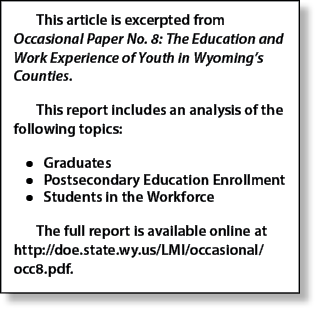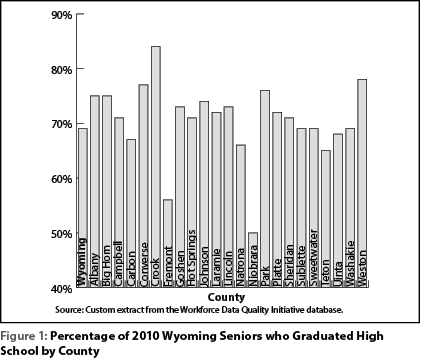The Education and Work Experience of Youth in Wyoming’s Counties
Since the late 1990s, the Research & Planning (R&P) section of the Department of Workforce Services has used administrative records in labor market studies, resulting in a better understanding of Wyoming’s labor force, market conditions, and dynamics. The administrative databases used for this study include unemployment insurance (UI) employer tax records, driver’s license database, and student records from the Wyoming Department of Education (WDE) and the Wyoming Community College Commission. Taken together, these datasets provide demographics, work history, and student data that allow further exploration of worker interaction with educational opportunity.

|
Once a student completes high school, he or she has many options for the future. Many Wyoming students enroll in a Wyoming community college, the University of Wyoming, or an out-of-state postsecondary institution, while others go directly into the workforce. This publication discusses the different pathways the senior class of 2010 is taking and how they differ among the counties in Wyoming. Students who are deceased or have moved out of the country or to a state that does not have a data sharing agreement with R&P are not accounted for in the current analysis.
This publication uses longitudinal analysis to explore the different paths taken by 2010 high school seniors. A longitudinal analysis begins with a cohort at a single point in time and follows the cohort to measure the changes that occur over time. In this case, the term cohort refers to the high school senior class of 2010.
Graduates
In 2010, 7,919 students made up the senior class and 5,481 seniors (69%) in Wyoming earned their high school diploma. The percentage of students who graduated by county ranged from 50% (Niobrara County) to 84% (Crook County). Fourteen out of the 23 Wyoming counties had a higher percentage of graduates than the state as a whole (see Figure 1).
Postsecondary Education Enrollment
Through a memorandum of understanding with the Wyoming Department of Education, R&P has access to the postsecondary education enrollment of Wyoming high school students in any state in the U.S. In 2010, 42% (3,287) of 2010 Wyoming seniors enrolled in postsecondary education. Of those 3,287 enrolled, 1,764 (54%) were female and 1,523 (46%) were male. The county with the highest percentage of students enrolled in postsecondary education was Goshen County (62%) and the lowest was Sweetwater County (31%).
In 2011, the percentage of 2010 seniors in Wyoming enrolled in postsecondary education declined slightly to 41% (3,275) while the percentage of females and males remained the same. The percentage of females enrolled in postsecondary education increased from 2010 to 2011 in 12 counties, while the percentage of males enrolled in postsecondary education increased in eight counties (see the Table). This increase in postsecondary enrollment could be the result of students going into the workforce and enrolling in postsecondary education to get additional training in their chosen field or postponing their college enrollment after high school graduation for a semester. Goshen County had the highest percentage of males from the 2010 senior class enroll from 2010 to 2013 while Albany County had the highest percentage of females enroll from 2011 to 2014.
Students in the Workforce
Students who do not enroll in postsecondary education may enter the workforce right away, while students who do enroll in postsecondary education may take longer to begin working. Other students may leave Wyoming or move to a state with which R&P does not have a data sharing agreement, and are considered not found for the purposes of this research. The percentage of 2010 seniors enrolled in postsecondary education and working, either in Wyoming or a partner state, was just above 30% and the number of 2010 seniors working and not enrolled in postsecondary education was almost 40% (see Figure 2). By 2014, the number of students enrolled and working dropped below 20% while the number of students not enrolled and working in Wyoming or a partner state increased.
The enrollment status of students has an effect on wages earned after secondary school. Overall, students not enrolled in postsecondary education tend to earn higher wages than enrolled students.
Conclusion
Wyoming secondary students have many different pathways they can take upon high school completion. Research & Planning has the tools to follow students into postsecondary education and the workforce to understand why students may leave Wyoming, or the labor force in general, and what leads to economic security of Wyoming high school students.



